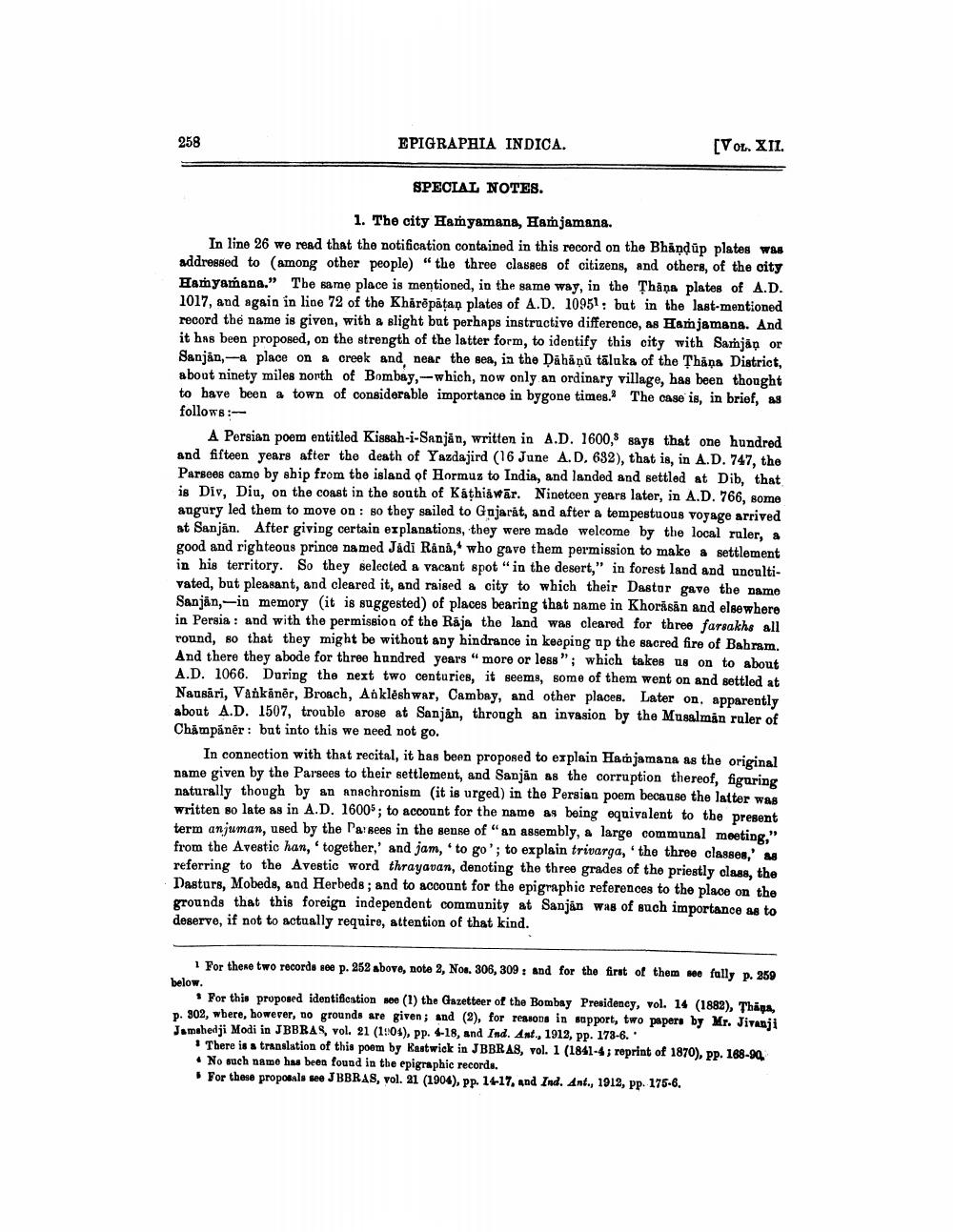________________
EPIGRAPHIA INDICA.
[VOL. XIL.
SPECIAL NOTES.
1. The city Hamyamana, Hamjamana. In line 26 we read that the notification contained in this record on the Bhandup plates was addressed to (among other people)" the three classes of citizens, and others, of the city Hamyamana." The same place is mentioned, in the same way, in the Thåns plates of A.D. 1017, and again in line 72 of the Khårēpåtan plates of A.D. 10951: but in the last-mentioned record the name is given, with a slight but perhaps instructive difference, as Hamjamana. And it has been proposed, on the strength of the latter form, to identify this city with Sarjan or Sanjan,-a place on a creek and near the sea, ia the Dahaņu tāluka of the Thana District, about ninety miles north of Bombay,--which, now only an ordinary village, has been thought to have been a town of considerable importance in bygone times. The case is, in brief, as follows:
A Persian poem entitled Kissah-i-Sanjän, written in A.D. 1600,9 says that one hundred and fifteen years after the death of Yazdajird (16 June A.D. 632), that is, in A.D. 747, the Parsees camo by ship from the island of Hormuz to India, and landed and settled at Dib, that is Div, Diu, on the coast in the south of Käthig wār. Nineteen years later, in A.D. 766, some angury led them to move on : so they sailed to Gujarát, and after a tempestuous voyage arrived at Sanján. After giving certain explanations, they were made welcome by the local ruler, a good and righteous prince na med Jadi Rana, who gave them permission to make a settlement in his territory. So they selected a vacant spot "in the desert," in forest land and uncultivated, but pleasant, and cleared it, and raised a city to which their Dastur gave the name Sanjan,-in memory (it is suggested) of places bearing that name in Khorasan and elsewhere in Persia: and with the permission of the Raja the land was cleared for three farsakhs all round, so that they might be without any hindrance in keeping ap the sacred fire of Babram. And there they abode for three hundred years "more or less"; which takes us on to about A.D. 1066. During the next two centuries, it seems, some of them went on and settled at Nausäri, Vankäner, Broach, Ankleshwar, Cambay, and other places. Later on, apparently about A.D. 1507, trouble arose at Sanján, through an invasion by the Musalman ruler of Champáner: but into this we need not go.
In connection with that recital, it has been proposed to explain Hamjamana as the original name given by the Parsees to their settlement, and Sanjän as the corruption thereof, figuring naturally though by an anachronism (it is urged) in the Persian poem because the latter was written so late as in A.D. 16005; to account for the name as being equivalent to the present term anjuman, used by the Pa Bees in the sense of "an assembly, a large communal meeting," from the Avestic han, 'together,' and jam, to go'; to explain trivarga, 'the three classes, as referring to the Avestic word thrayavan, denoting the three grades of the priestly class, the Dasturs, Mobeds, and Herbeds; and to account for the epigraphic references to the place on the grounds that this foreign independent community at Sanjan was of such importance as to deserve, if not to actually require, attention of that kind.
For these two recorda see p. 252 above, note 2, Nos. 306, 309: and for the first of them see fully p. 259 below.
• For this proposed identifestion 10 (1) the Gazetteer of the Bombay Presidency, vol. 14 (1882), Thapa, p. 302, where, however, no grounds are given; and (2), for reasons in support, two papers by Mr. Jivanji Jamshedji Modi in JBBBAS, vol. 21 (1904), pp. 4-18, and Ind. Ast., 1912, pp. 173-6.'
• There is a translation of this poem by Kastwick in JBBR AS, vol. 1 (1841-4; reprint of 1870), PP. 168-99 • No such namo has been found in the epigraphic records.
For these proposals see JBBRAS, vol. 21 (1904), pp. 14-17, and Ind. Ant., 1912, pp. 176-6.




